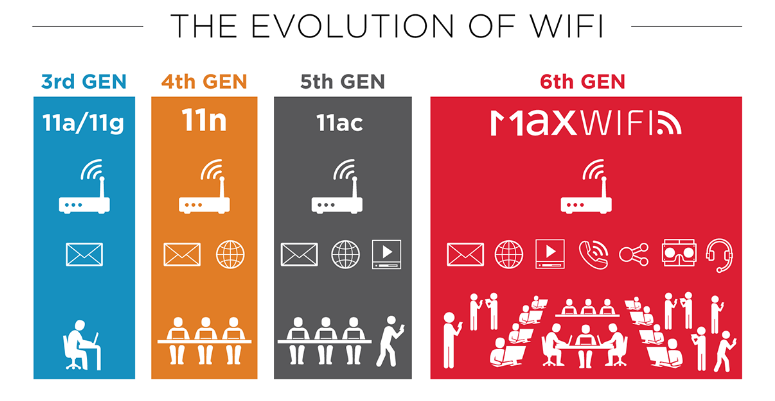Related post: The updated guide to WiFi wireless network connectivity The 6th generation of WiFi dubbed WiFi IEEE 802.11 ax or WiFi 6 is expected to solve some of these challenges. WiFi 802.11 ax also now being marketed as WiFi 6 since the adaption of the numeric version convention was released late 2019 succeeding 802.11 ac the latest standard. The new standard is 10 times faster than the latest standard and is designed to operate in existing 2.4 GHz and 5GHz frequency spectrum. This means it will also be backward compatible with WiFi 802.11 a/b/g/n/ac devices. Summarily, WiFi 6 brings the following improvements;
Higher data ratesIncreased capacityPerformance in environments with many connected devicesImproved power efficiency
Brief history of WiFi
WiFi has come a long way ever since its first commercial introduction in 1997. Back then, speeds were only 2 Mbit/s but this was improved to 11 Mbit/s link speeds with 802.11 b(WiFi2) in 1999 which made the wireless standard very popular. WiFi 802.11g(WiFi3) was soon released in 2003 introducing Orthogonal Frequency Division Multiplexing (OFDM) technology that provided higher data rates and improved multipath performance. This increased transmission speeds to 54Mbps. Related post: WiFi 802.11 ac vs ax vs ad: it’s a choice of speed over distance Later on, WiFi 802.11n(WiFi4) came in 2009 supporting up to four MIMO streams in both 2.4Gh and 5Ghz bands pushing speeds slightly higher to 150Mbps. WiFi 802.11ac (WiFi5) aka Gigabit WiFi introduced MIMO-OFDM modulation on 2.4Gh and 5Ghz bands pushing speeds further to 1 Gbps using two spatial streams. WiFi has had 5 revisions so far and the next version aptly named WiFi 6 or 802.11 ax promises even more wireless connectivity improvements.
How fast is 802.11 ax(WiFi6)?
The new 802.11 ax will be roughly 14Gbps fast using four 160MHz channels given that each stream is capable of 3.5Gbps. Wi-Fi 6 expands the WiFi band from 80 MHz to 160 MHz, doubling the channel width and creating a faster connection from your router to the device. It’s a bit like having a wider road that carriers more cars at ago. Related post: Why The New 6 GHz Wi-Fi Band (Wi-Fi 6E) Matters A single a single 802.11ac stream meanwhile can push 866Mbps data rate. A single 80MHz channel on the other hand on 802.11ax is capable of pushing 1.6Gbps bandwidth. Multiply this by 4 streams and you have roughly 6.4Gbps. Four 40MHz channels give you a total network capacity of 3.2Gbps. So yes 802.11ax is a significant upgrade to the current 802.11ac standard.
Better power management
WiFi6 promises better power management features that its predecessor. With a feature called Target Wake Time (TWT), WiFi devices can communicate with a WiFi 6 router whey are available to transmit/receive data and when they are asleep in which case nothing is transmitted. This dramatically saves battery life especially for smaller IoT devices.
Better interference management
Since there are over a billion WiFi devices in the wild, there is a lot of interference and congestion with the 2.4 GHz and 5GHz frequency spectrum. The result is slow internet connections. According to Broadcom, the leader in manufacturing WiFi chips, WiFi IEEE 802.11 ax introduces a scheme to reduce interference and use the spectrum even more efficiently called Spatial Reuse with Color Identifier. Each Wi-Fi access point and client transmits data with a unique identifier called a “color”. Wi-Fi device “listens” for interference before sending data, and will back off if it senses data in the band. With 802.11ax, when an access point or a client listens first before transmitting data, they are more aggressive if they hear data from a different color, since that data is going to a different AP further away from the client. Generally 802.11 ax is expected to improve traffic flow and channel access, better power management and therefore longer battery life for your devices. Related post: Asus launches world’s first 10 Gigabit tri-band 802.11ax WiFi router Already some major vendors have started rolling out WiFi 802.11 ax chips. Qualcomm announced their first 802.11 ax silicon on February 13, 2017 while Broadcom announced their 6th Generation of Wi-Fi products with 802.11 ax support also known as WiFi Max on August 15, 2017. These chips are now being tested in upcoming 802.11 ax routers and access points. On August 30, 2017, Asus announced the first 802.11 ax router while Huawei announced their first 802.11 ax access point on On September 12, 2017. Early 2019, Cisco announced the Catalyst 9100 WiFi 6 access points. In 2020, almost all the big network router vendors such as Netgear, Asus, TP-Link, D-Link have WiFi 6 routers in the market. Read more: Top 5 Wi-Fi 6(802.11ax) Router brands and their products



